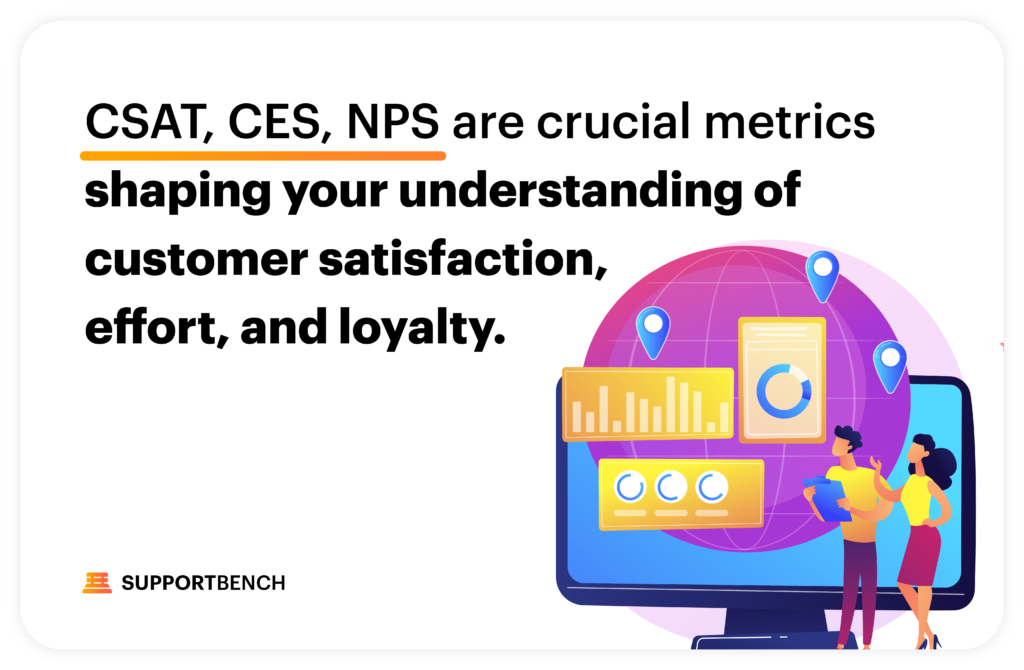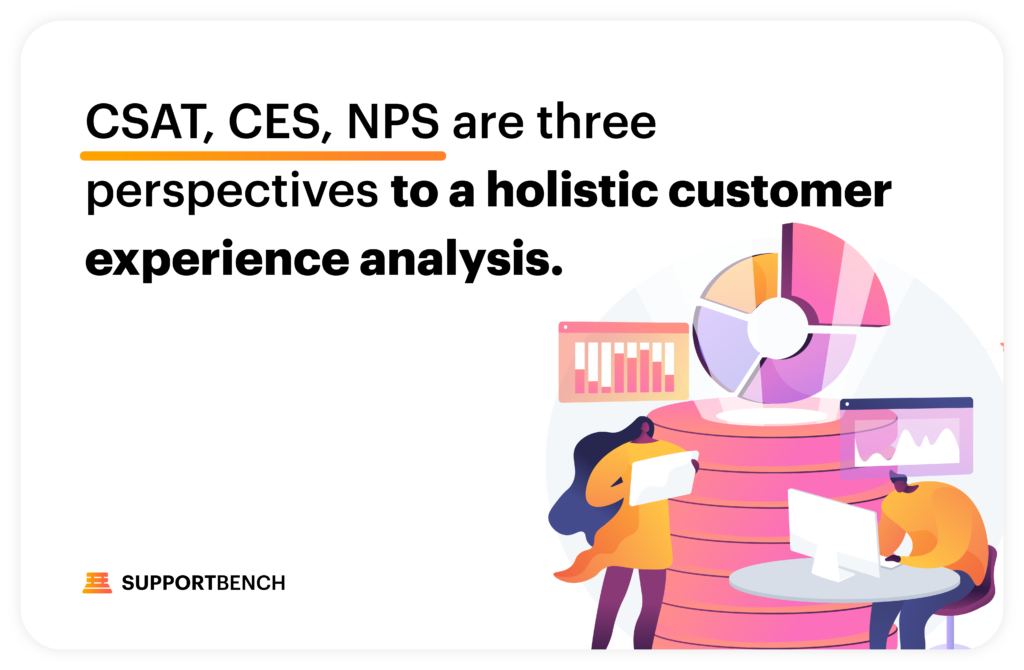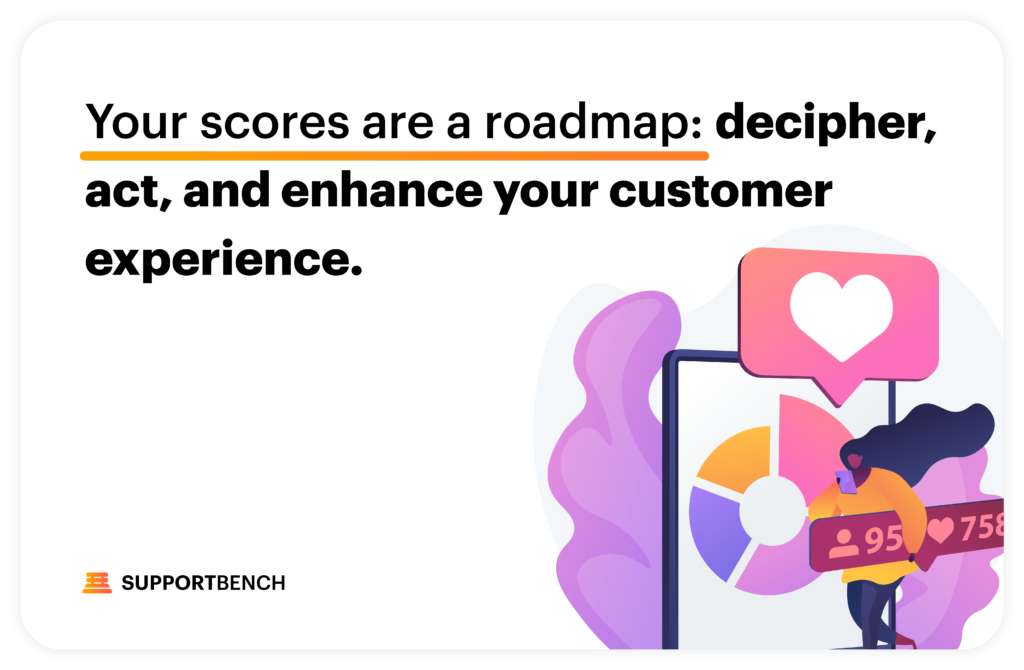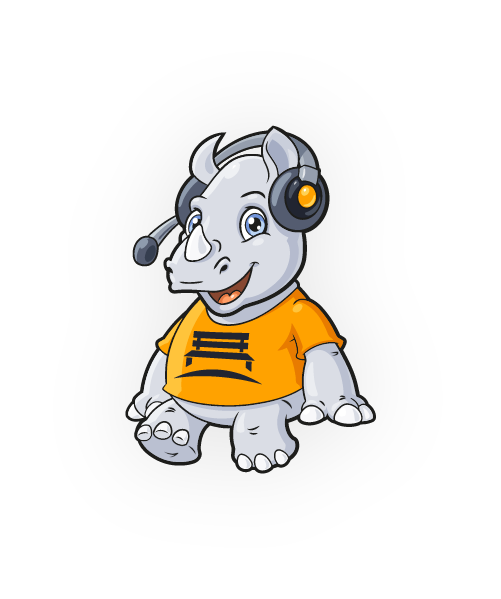In the ever-evolving world of customer support, the landscape is peppered with acronyms. Among these, CSAT, CES, and NPS stand as the holy trinity, each providing unique insights into the customer experience. As a veteran in this arena, I’ve seen businesses wrestle with these metrics, often unsure of their purpose, how to best measure them, or how to act on the results.
So, let’s dispel the fog of confusion around these metrics. We’ll take a deep dive into what each one is, the pros and cons of measuring them, the best practices for their implementation, and how they can be used to calculate health scores. We’ll also discuss the value of using these metrics together and provide actionable insights to leverage their potential fully.
Understanding CSAT, CES, and NPS

CSAT: The Agent-Level Metric
Customer Satisfaction Score (CSAT) is a straightforward, time-tested metric that measures the customer’s satisfaction with a specific product, service, or interaction. Typically, a CSAT survey asks the customer to rate their satisfaction on a scale of 1 (very dissatisfied) to 5 (very satisfied). This score provides an immediate snapshot of how well a company or, more specifically, an agent, meets customer expectations.
Pros of CSAT:
The primary advantage of CSAT is its specificity. By focusing on individual transactions or touchpoints, it can help pinpoint areas of strength and weakness in your support process. High CSAT scores can also be a powerful marketing tool, showcasing the effectiveness of your support team.
Cons of CSAT:
CSAT’s strength is also its weakness. Its specificity means it may not reflect the overall customer experience or long-term loyalty. Furthermore, cultural differences can affect responses, and the fact that most customers who respond to CSAT surveys are either very satisfied or very dissatisfied can lead to skewed results.
CES: The Process-Level Metric
Customer Effort Score (CES) evaluates the ease of interaction with a company. It asks customers to rate the effort they had to put in to have their issue resolved. Typically, customers are asked: “On a scale from 1 (very low effort) to 5 (very high effort), how much effort did you personally have to put forth to handle your request?”.
Pros of CES:
CES measures the ease of a customer’s experience, which can be a powerful predictor of customer loyalty. Research by Gartner found that 96% of customers with a high-effort service interaction become more disloyal compared to just 9% who have a low-effort experience.
Cons of CES:
Despite its usefulness, CES does have its limitations. It does not measure the entirety of the customer journey, and like CSAT, can be influenced by cultural differences. Moreover, it doesn’t consider the positive effects of delighting customers, focusing instead on making experiences effortless.
NPS: The Macro-Level Metric
Net Promoter Score (NPS) gauges customer loyalty by asking customers how likely they are to recommend the company to others, on a scale of 0-10. Customers are then grouped into Promoters (9-10), Passives (7-8), and Detractors (0-6), with the NPS being the percentage of Promoters minus the percentage of Detractors.
Pros of NPS:
NPS is a robust, widely recognized measure of overall customer loyalty. It correlates well with growth and has been proven to be a reliable metric for benchmarking against competitors.
Cons of NPS:
Despite its benefits, NPS is not without drawbacks. It doesn’t provide specific insights into areas of dissatisfaction nor does it account for cultural differences in scoring. Additionally, it tends to overlook ‘passive’ customers, who could become promoters with a little nudge.
Measuring CSAT, CES, and NPS: Best Practices

Measuring CSAT
CSAT surveys should be sent out after key customer touchpoints, such as interactions with customer support, purchases, or product implementations. Customers should be asked to rate their satisfaction on a scale from 1 to 5, with the option to leave additional comments for more nuanced feedback.
To calculate CSAT, add up all the positive responses (usually those who responded with a 4 or 5), divide that by the total number of responses, and multiply by 100 to get a percentage. The closer to 100%, the higher the customer satisfaction.
Measuring CES
CES surveys should be sent out after customer service interactions. They ask customers to rate the effort it took them to get their issue resolved, on a scale of 1 (very low effort) to 7 (very high effort).
To calculate CES, you can simply average the scores of all respondents. A lower CES indicates a more effortless experience.
Measuring NPS
NPS surveys can be sent out quarterly, bi-annually, or annually. They ask customers to rate how likely they are to recommend the company to a friend or colleague on a scale of 0-10.
To calculate NPS, categorize respondents into Promoters (9-10), Passives (7-8), and Detractors (0-6). Subtract the percentage of Detractors from the percentage of Promoters to get your NPS. The score can range from -100 to 100, with anything above 0 considered ‘good’ and above 50 considered ‘excellent’.
The Power of Combining CSAT, CES, and NPS
While each of these metrics provides valuable insights, they are most powerful when used in conjunction. Together, they offer a more holistic view of the customer experience at different levels: the agent-level (CSAT), the process-level (CES), and the overall company-level (NPS).
Implementing all three doesn’t seem to impact response rates significantly, but instead provides a more comprehensive picture of the customer journey. Understanding the interplay between these metrics allows support leaders to identify specific areas for improvement and take targeted actions to boost customer satisfaction, reduce effort, and increase loyalty.
For instance, low CSAT scores coupled with high CES scores could indicate that while your support agents are performing well, the overall process is too complicated for customers. This insight would direct you to simplify your support process, rather than investing in additional agent training.
Measuring Frequency: Striking the Right Balance
Determining how often to measure these metrics requires a delicate balance. Over-surveying can lead to survey fatigue, reducing response rates and potentially skewing your data. Under-surveying, on the other hand, could leave you in the dark about emerging trends or issues in your customer experience.
As a rule of thumb, CSAT and CES should be measured after key touchpoints or interactions, while NPS should be measured less frequently to track broader trends in customer loyalty. This allows you to capture immediate feedback on specific interactions (CSAT and CES) and longer-term customer sentiment (NPS) without overwhelming your customers with surveys.
Leveraging CSAT, CES, and NPS to Calculate Health Scores
With or without a platform like Supportbench, these scores can be used to calculate customer health scores, providing a comprehensive view of the customer’s relationship with your company. Health scores typically take into account a variety of factors, including product usage, support interactions, and of course, feedback metrics like CSAT, CES, and NPS.
To calculate a health score using these metrics, you could assign different weights to each based on their relevance to your business. For instance, you might decide that CES is the most important factor (due to its correlation with loyalty), followed by CSAT and then NPS. You could then create a scoring system that integrates these weights, such as:
Health Score = (0.5 * CES) + (0.3 * CSAT) + (0.2 * NPS)
This formula is just an example; the specific weights and calculations would need to be tailored to your business and your customers. The key is to ensure that the health score accurately reflects the overall health of the customer relationship.
Interpreting and Actioning on Your Scores

Once you’ve calculated your CSAT, CES, NPS, and overall health scores, the next step is to use these insights to drive improvements in your customer experience. Here are a few actionable strategies based on different score scenarios:
Low CSAT, High CES, High NPS: This combination could suggest that while customers find your process easy and are generally loyal, there are issues with specific interactions or touchpoints. In this case, you might conduct a deep dive into your CSAT feedback to identify pain points and provide targeted training for your agents.
High CSAT, Low CES, High NPS: This might indicate that customers are satisfied with individual interactions but find the overall process too complex. Here, you could focus on streamlining your processes and making it easier for customers to get the help they need.
High CSAT, High CES, Low NPS: This could suggest that while customers are happy with your support and find the process easy, they’re not sufficiently impressed to recommend you to others. This might call for initiatives to ‘wow’ your customers and turn them into advocates.
Low Health Score: A low health score, regardless of the individual CSAT, CES, and NPS scores, signals a risk of churn. These customers should be prioritized for outreach and intervention. You could develop personalized engagement plans to address their specific issues and concerns.
In Summary
In the ever-evolving landscape of customer support, metrics like CSAT, CES, and NPS offer invaluable insights into how your business is performing from the customer’s perspective. But understanding these metrics is just the first step; the real magic happens when you leverage these insights to drive actionable improvements in your customer experience.
Whether you’re a seasoned support leader or just stepping into the role, I hope this guide has provided you with a deeper understanding of these key metrics and how to use them to elevate your support operations. Remember, the goal is not to chase perfect scores, but to listen, learn, and continually strive to do better for your customers.
Because in the end, that’s what customer support is all about: being there for your customers, understanding their needs, and going above and beyond to ensure their success. And as we continue to navigate this exciting journey, I look forward to seeing how we, as a community of support leaders, will use these tools to shape the future of customer support.











